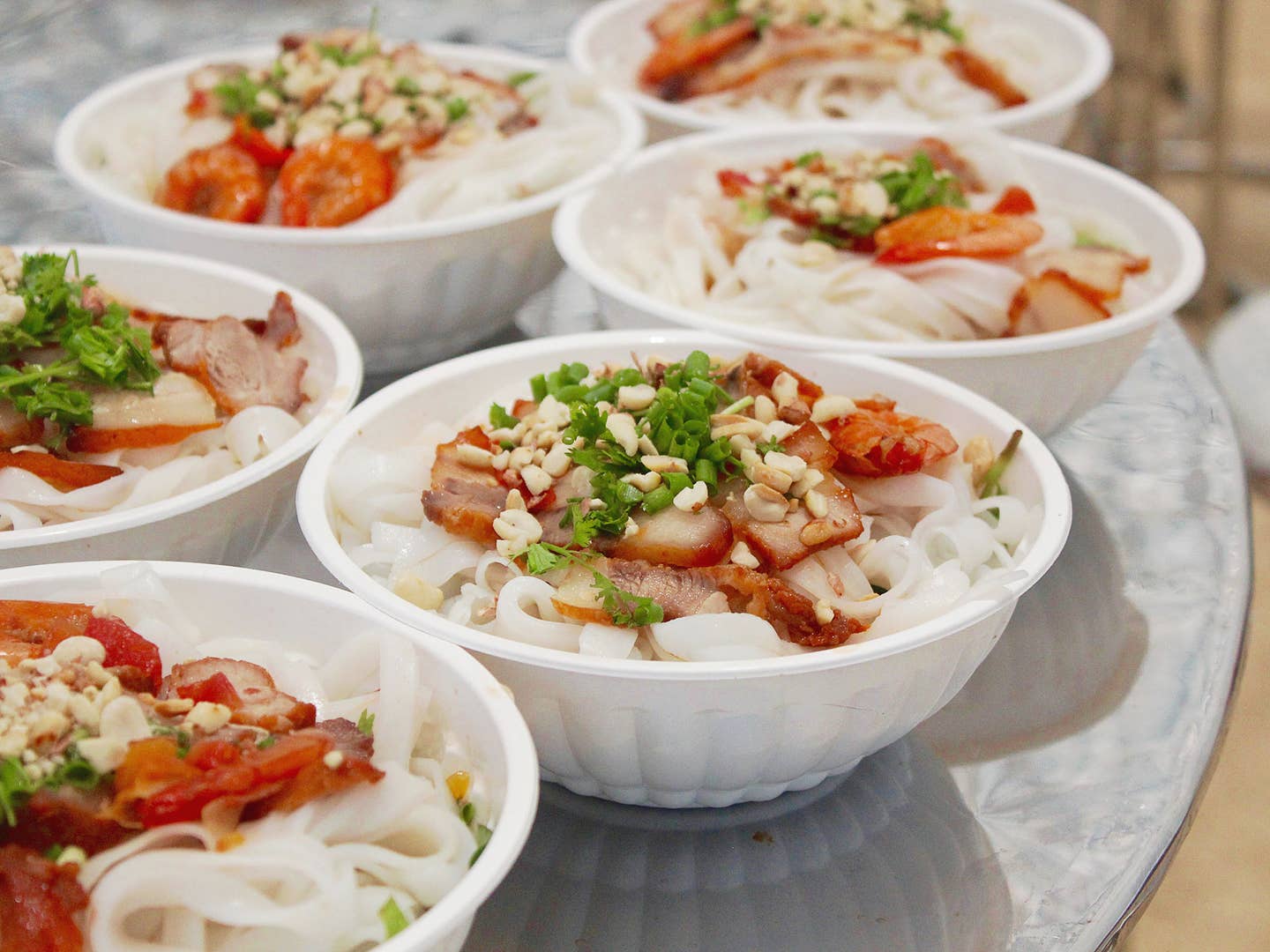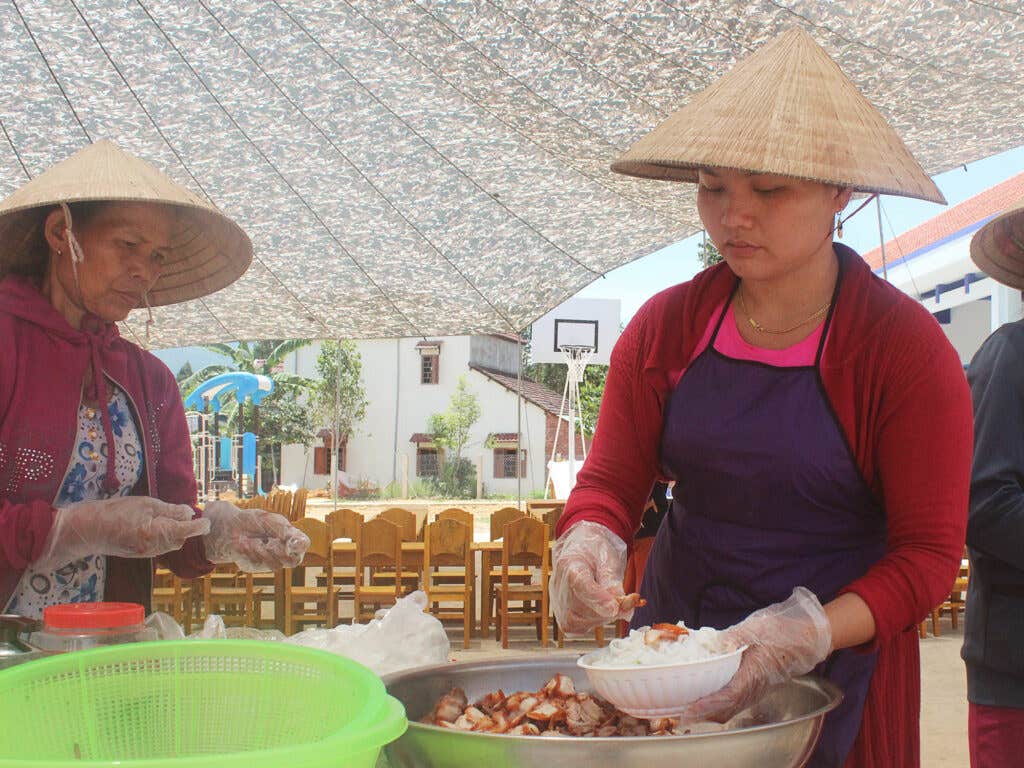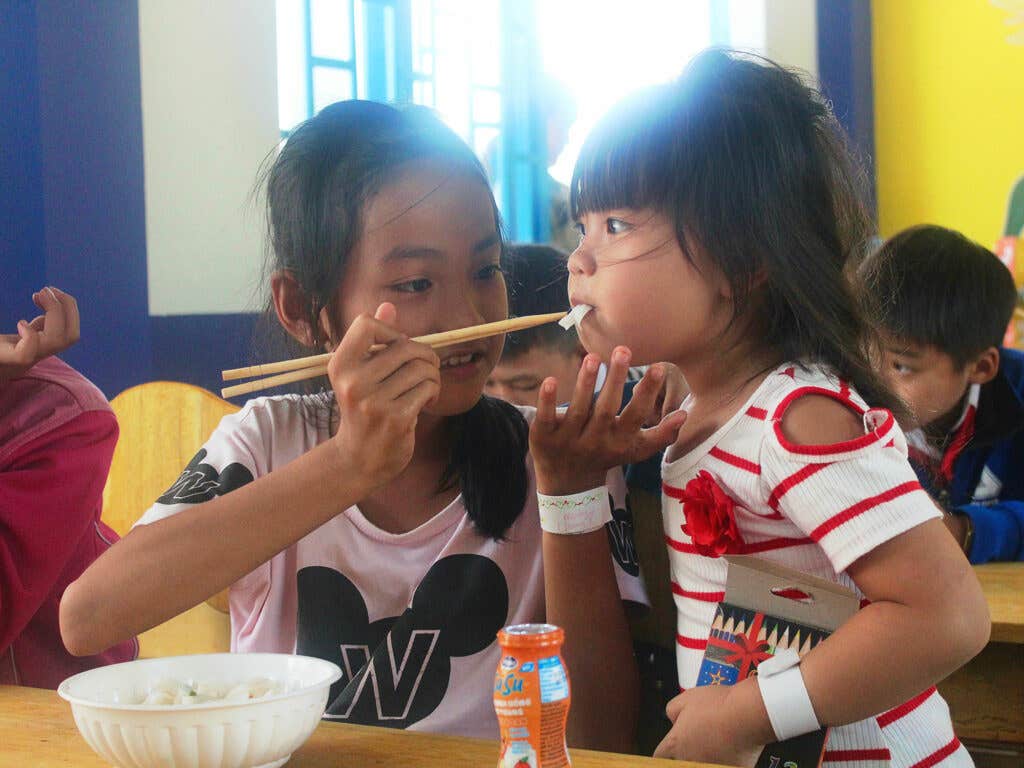
The World’s Best School Lunch Costs $1
But for some rural Vietnamese students, that cost is still one of many barriers to accessing education
11 a.m., Quảng Nam Province, Vietnam
The pot of pork broth burbles on the outdoor stove, clouds of steam billowing into the windless, 100-degree air. “It’s almost ready,” says Suong, a shopkeeper, wiping beads of sweat from her forehead. She’s been up since 5 a.m. buying groceries, chopping vegetables, and making stock on the propane burners in front of her house-turned-corner store. She’s been hired to prepare a feast for 100 students attending a new elementary school across the road, a group that includes her own daughter.
Those students, dressed in the national uniforms of white short-sleeved button-downs, blue pants, and red handkerchiefs, have walked as long as an hour to reach their school. And on most days, they'll have to make the trip back home for lunch, which Vietnamese schools rarely provide. But today's different—an international NGO is hosting a full day of arts, robotics, 3D printing, and English language workshops for the students and their teachers—and Suong has prepared mì Quảng, the famous noodle soup of Quảng Nam. Each bowl starts with wide rice noodles topped with a broth of pork bones, fish sauce, black pepper, shallots, and garlic. Then come a few slices of pork, and, as a special treat, a single shrimp for each.
Some students, like fourth-grader Thuy, have brought their younger siblings to share their bowls.

It's a two-hour drive up a mountain from the provincial capital, Tam Kỳ, to reach the remote Tiên Ngọc elementary school, funded and built by an education NGO called the Sunflower Mission (disclosure: I volunteer with the organization). As with much of central Vietnam, where ground fighting was often the most brutal, the area has never fully shaken off the vestiges of war. A former GI we meet at our hotel in Tam Kỳ has been contracted to decommission still-active landmines; our bus driver tells me he's got a side gig with a medium, helping families still searching for the bodies of their husbands and sons; elderly townspeople missing limbs congregate in the courtyard of our pop-up medical clinic.
The history of Vietnam is steeped in trauma, but the future is hopeful and bright. The latest World Bank figures show the country's per-capita GDP to be the fastest growing in the world. More importantly, poverty rates have fallen dramatically, from 60 percent in 1993 to 13 percent in 2014, a difference of some 40 million people. But while the average annual income in Vietnam has risen to $2,200, the figure in rural areas lags behind at less than $1,000.
Poverty in Vietnam is currently defined as making less than $374 a year, with the most vulnerable communities in the countryside and mountains. These are often the homes of the country's ethnic minorities, who make up less than 15 percent of the population but over 40 percent of the poor.

The country's poverty trap begins as early as elementary school for kids like those at Tiên Ngọc. With little assistance from the government—the state policy is to subsidize about 10,000 dong, or 50 cents, a day for poor children—many schools are unable to feed their students during the day, forcing them to make the journey home and back in the sweltering heat for a meal before continuing their afternoon classes (depending on the region, many rural students only attend one session of classes, returning to the fields after lunch).
The consequences are many: At best, time that should be spent learning is lost on commuting; at worst, children who also lack access to nutritious food at home are severely underweight and face a number of health problems. If they’re lucky enough to reach high school, it’s an all-too-common tale for the more conscientious among them to leave their studies and start working full-time to help their families.
Don Tuan Phuong, founder of the Hanoi-based Center for Sustainable Development Studies (CSDS), has worked specifically to advance access to nutrition for elementary school students through lunch offerings. "In the mountainous regions, there are many students who sleep at a state boarding school far from home during the week," he tells me via e-mail. "They are required to take care of their own food, bringing whatever they have at home, so there's a great need for these children in the uplands."
Phuong admits that there's not much official research to point to yet, but in every project thus far, attendance rates have increased as a result of lunch being provided in school. The World Bank corroborates these findings, having successfully implementing the School Readiness Promotion Project that increased full-day, full-year enrollment in preschools from 66 percent of five-year-olds in 2011 to 84 percent by 2015. One key strategy of the initiative was the "provision of lunch subsidies for poor and ethnic minority children to promote demand."

The kids' happy shrieks have subsided into a hum of noodle slurping, and I watch Thuy pick up some noodles to feed her younger sister Quynh, who's squeezed onto a tiny school chair next to her. The bowl the girls are sharing costs just 22,000 Vietnamese dong—about one U.S. dollar—but with some meat and a shrimp, it's likely more nutritious than the protein-deficient meals they often get at home. Even though it's the region's most famous dish, mì Quảng is a luxury to these students, who tangle up every last strand as Suong walks around refilling bowls with broth.
After an afternoon break, the kids head back into classrooms for a second round of workshops. We ask Thuy to tell us, in English, what she wants to be when she grows up. “I want to be a teacher,” she says nervously. We, her teachers for the day, smile back. I can't say whether a bowl of noodles every day at school is enough to make her dream a reality, but I hope for a future where worrying about what to eat isn’t preventing her from trying.
Keep Reading
Continue to Next Story










